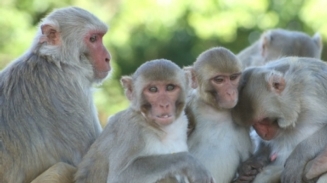
看着做!猴子们!
Made Ya Look, Monkey
看着做!猴子们!
Over their lifetimes, macaques follow the same trajectory as humans in the amount of interest they have in observing what another individual is looking at.
在猕猴的一生中,它们对其他个体所注视的事物保持浓厚的兴趣,而这种机制与人类十分相似。
播音/撰文 Karen Hopkin
翻译 Meatle
审校 吴非
统筹 李轩
We’ve all heard the adage: monkey see, monkey do. But it is literally true—if a monkey sees you looking at something, it will look, too. Now, a study shows that this tendency for a monkey to track what another is looking at is age-dependent. And in a very similar way to the same behavior in people.
我们都熟知这条熟语:有样学样(monkey see, monkey do)。在字面上,这条熟语完全正确——如果猴子看到你在注视着什么,它们会沿着你的目光看去。一项最新的研究表明,猴子跟随其他个体视线的行为与它们的年龄相关,而且与人类的同种行为相似。
The ability to what’s called “gaze-follow” is a fundamental skill that underlies our social lives. When we turn to see what other people see, we recognize their interest and join in their curiosity—or concern. Stand on a busy street corner and look up. It won’t be long before you have a crowd of people trying to see what it is you’re looking at. And other primates do it, too.
这种称为“目光跟随(gaze-follow)”的行为是社会生活中的基本行为。当我们看别人所注目的东西时,我们能分享到他们的好奇心,或者关心的东西。试着站在人来人往的街角往天上看,不久就会有里外三层的人尝试找到你所(假装)看着的东西。其他灵长类同样如此。
Researchers studied a large population of free-ranging macaques on an island off Puerto Rico. One scientist would approach a macaque that was sitting by itself and would attempt to get its attention by clapping or snapping or by saying, “Monkey, monkey.” That’s lead investigator Alexandra Rosati of Harvard. When the macaque made eye contact, Rosati would look straight up in the air. A second researcher would film the interaction to see whether the monkey also looked up.
研究人员对一个大型的猕猴种群进行了研究,这些猕猴自由分布在波多黎各的一座岛屿上。这项研究的首席调查员,哈佛大学的Alexandra Rosati靠近一只独自坐着的猕猴,通过拍掌、打响指或者嚷嚷“猴子,猴子”来吸引猕猴的注意力。她与猕猴四目对视时会突然朝天望去,这时其他的研究人员就会拍下猕猴的反应,以确定它是否也会望天。
The humans pulled the same stunt on nearly 500 monkeys of all different ages, from infants just two weeks old to elders of 28 years. And they found that, for macaques, gaze following kicks in a few months after birth, peaks in juveniles, and declines in old age—a pattern that matches what happens in humans. To see the results for yourself, take a look at the write-up in theProceedings of the Royal Society B. [Alexandra G. Rosati et al.,Rhesus monkeys show humanlike changes in gaze following across the life span]
研究人员对近500只猕猴耍了这样的把戏。它们的年龄从刚出生两周到28岁以上的高龄。他们发现,视觉追随行为在猕猴出生数月后就出现,在猕猴达到少年时表现得最为强烈,在老年时逐渐退却——这刚好与人类身上的趋势不谋而合。这篇文章发表在《皇家学会学报B》(Proceedings of the Royal Society B)期刊上。
The researchers also found that juvenile and adult macaques quickly figured out that Rosati was faking: when she looked up, there wasn’t actually anything in particular worth seeing. At which point the clever primates disengaged from the activity. Which suggests that, yes, you can make a macaque look. But you can’t make it a monkey’s uncle.
研究人员还发现,正值少年和青壮年的猕猴能快速识破Rosati的骗局:在她的视线中并没有有趣的事物。于是这些聪明的动物就移开了自己的视线。这告诉我们,我们能让猕猴朝着我们的视线看去,但它们并不会信以为真。
未经书面许可任何人不得复制或镜像
京ICP备11000850号-1
 京公网安备11010502039775号
京公网安备11010502039775号 信息网络传播视听节目许可证0111611号
国家科技基础条件平台

















